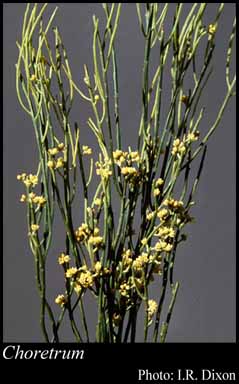- Reference
- Prodr.Fl.Nov.Holland. 354 (1810)
- Name Status
- Current

Scientific Description
Common name. Sour-bushes. Family Santalaceae.
Habit and leaf form. Shrubs. Switch-plants; with the principal photosynthesizing function transferred to stems. Leaves much reduced. Plants with roots, or rootless; partially parasitic. On roots of the host. Stem internodes solid. Mesophytic, or xerophytic. Leaves alternate; membranous (scales); petiolate to sessile; gland-dotted, or not gland-dotted; aromatic, or without marked odour; simple; pulvinate. Leaf blades entire; scale-like; one-veined, or pinnately veined. Leaves without stipules. Leaf blade margins entire. Leaf anatomy. Extra-floral nectaries absent. Stem anatomy. Secondary thickening developing from a conventional cambial ring.
Reproductive type, pollination. Fertile flowers hermaphrodite. Unisexual flowers absent. Plants hermaphrodite.
Inflorescence and flower features. Flowers solitary, or aggregated in ‘inflorescences’; in fascicles (or clusters). The terminal inflorescence unit cymose, or racemose. Inflorescences axillary; fascicles or clusters; with involucral bracts (flowers surrounded by an involucre of 2 to 4 or more minute, scale-like bracts). Flowers bracteate (A); bracteolate (2 or more per flower); small; regular; (4–)5 merous; cyclic; tricyclic. Free hypanthium present, or absent; KPB describe the floral tube in the Santalaceae but without reference to Choretrum. Perianth sepaline; 5 (or 4); 1 -whorled; joined (the lobes valvate); sepaloid; fleshy, or non-fleshy; persistent. Calyx (‘calycode’) (4–)5; 1 -whorled; gamosepalous; valvate; turbinate; regular; fleshy, or non-fleshy; persistent. Androecial members definite in number. Androecium 5. Androecial members free of the perianth, or adnate; all equal; free of one another; 1 -whorled. Androecium exclusively of fertile stamens. Stamens 5; all more or less similar in shape; isomerous with the perianth; oppositisepalous (opposite the perianth segments and near their bases); filantherous, or with sessile anthers. Filaments appendiculate (sometimes), or not appendiculate. Anthers basifixed; dehiscing via longitudinal slits; introrse; four locular; tetrasporangiate. Gynoecium (2–)3(–5) carpelled. The pistil 1 celled. Carpels reduced in number relative to the perianth to isomerous with the perianth. Gynoecium syncarpous; synstylovarious, or eu-syncarpous; inferior. Ovary unilocular; 1 locular. Epigynous disk present. Gynoecium stylate. Styles 1; apical. Stigmas 1; obscurely 2–5 - lobed. Placentation basal, or free central. Ovules differentiated to not differentiated; in the single cavity 2; pendulous; hemianatropous to anatropous.
Fruit and seed features. Fruit fleshy; indehiscent; a drupe; 1 celled; 1 seeded. Seeds endospermic. Endosperm oily, or not oily. Seeds without a testa. Cotyledons 2.
Etymology. From the Greek for "separate from" and "belly"; the torus is separated from the perianth.